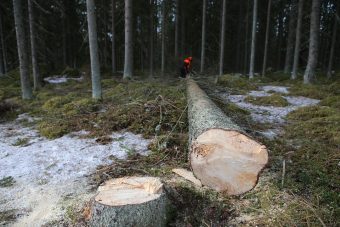
There is no future for business as usual.
Our current economic system, which arguably has succeeded in creating unprecedented economic output, wealth and human welfare over the past 70 years, has led to exacerbated social inequalities and loss of nature at an extent that threatens the stability of our economies and societies – and could maybe even lead to a collapse of civilisation as we know it.
To add some numbers: over 70 percentage of us are affected by rising inequalities, a third of the world’s land is severely degraded, we are losing forests at an alarming rate (one football field of forests every six seconds in 2019), and up to 1 million species are threatened with extinction.
Over half of the world’s GDP ($44 trillion) is threatened by such nature loss. The system is not working.
Turning the tide requires deep transformations of socio-economic systems, as highlighted by the World Economic Forum’s New Nature Economy Report II on “The Future of Nature and Business”.
For example, the sustainable management of forests can create $230 billion in business opportunities and 16 million jobs by 2030. Shifting the energy and extractives socio-economic system to circular and resource-efficient models can lead to $2.3tn in business opportunities and 30 million jobs by 2030, and working with nature in the infrastructure and built environment system can generate a total of $3 trillion business opportunities and 117 million jobs by 2030.
To accelerate the transformation towards a climate- and nature-positive economy, His Royal Highness The Prince of Wales has established The Circular Bioeconomy Alliance. The Alliance activities are guided by a 10-point Action Plan, co-created by a multi-stakeholder coalition with the goal to place nature back at the centre of our economy.
More:
“I have been deeply encouraged by the number of scientists and practitioners who have come together to develop a 10-point Circular Bioeconomy Action Plan inspired by my Sustainable Markets Initiative and its Circular Bioeconomy Alliance,” he said.

“It is time for leaders, across all disciplines, to step forward, be bold in their ambition and demonstrate what is possible so that others can follow.”
A new framework
A circular bioeconomy offers a conceptual framework for using renewable natural capital to transform and manage our land, food, health and industrial systems, with the goal of achieving sustainable wellbeing in harmony with nature.
While the circular bioeconomy needs advanced technology and innovation as well as traditional knowledge to succeed, it ultimately relies on biodiversity as its true engine.
This is because biodiversity determines the capacity of biological systems to adapt and evolve in a changing environment, and therefore is crucial for ensuring the resilience and sustainability of our biological resources.
We need to acknowledge this fundamental role, not only through appropriate conservation measures, but also through regionally-tailored market-based instruments to provide incentives for farmers, forest owners and biobased companies to invest back in biodiversity.
Biological resources are central to a circular bioeconomy
Moving towards a climate- and nature-positive economy not only means replacing fossil energy with renewable energy, it also means moving to fossil-free materials, substituting carbon-intense products like plastics, concrete, steel and synthetic textiles for lower carbon alternatives. This helps to mitigate climate change and also provides other positive environmental impacts. A climate- and nature-positive economy is simply not possible without using a new range of renewable biobased materials that can replace and outperform carbon-intense materials.

This shift is also an opportunity to modernize and make industries more circular: renewable biological resources like forest resources, are, if managed sustainably, circular by nature and often easier to remanufacture. Indeed sustainable forestry and wood products were the basis for original circular economies around the world. Several important sectors like chemicals, textiles, plastics or construction now need new conceptual business models and innovations to become more circular and lower carbon industries. The circular bioeconomy can be a catalyst.
For example, we can now transform wood, the most versatile biological material on earth, into a new revolutionary material called nanocellulose: five times stronger than steel but also five times lighter. The first car made of nanocellulose was unveiled last year in Japan. A new generation of sustainable and circular wood-based textiles with a five-times lower carbon footprint than plastic fibres like polyester is now possible too. Engineered wood products, such as Cross Laminate Timber (CLT),are the most effective way to reduce the carbon footprint of our buildings and the construction sector, currently dominated by two carbon-intense and resource-intense materials: concrete and steel.
Since biological resources, even if renewable, are not unlimited, it is essential to stress the need to ensure sustainable, regenerative and circular forestry or feedstock systems. We need to develop business models and design products and services in new ways to decouple business prosperity from the mere consumption of products. It is also about making products that can be easily reused and recycled, minimising waste and maximising their value along their life cycle.
An opportunity to tackle inequality
One of the most important societal challenges of this century is to address inequalities and to ensure inclusive prosperity, including jobs and infrastructures in rural and “depressed” areas. The way biological resources are owned and distributed and even the difficulties related to their mobilisation, transport and processing offer potential opportunities. Forest resources in Europe are a good example: they occupy more than 40 percentage of the land and are owned by about 16 million forest owners. The forest-based sector already now includes around 400,000 companies, mostly small enterprises, and provides more than 3 million jobs. This is a very valuable socio-ecological infrastructure that needs to be acknowledged and nurtured. It is true that mobilising, transporting and processing fossil resources like oil is much easier than producing, managing (for 100 years), transporting and processing wood. But this difficulty is at the same time its strength: redistributing wealth, jobs and infrastructures will ensure that we have human capital ready to take care of our natural capital.
Source: World Economic Forum



